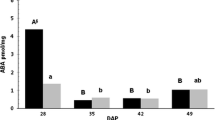Abstract
Changes in the levels of indole-3-acetic acid (IAA) and abscisic acid (ABA) in tomato (Lycopersicon esculentum Mill.) fruit pericarp tissue during development through ripening were measured by GC-SIM-MS using d3-ABA and 13C6-IAA internal standards. In the two cultivars of fieldgrown tomatoes analyzed, the highest IAA levels (8–24 ng/g fw) were found at the earliest stage of development (7 days after anthesis) followed by a rapid decline in levels of the hormone. ABA levels of 40–60 ng/g fw were found at the earliest stages of development followed by a decline in levels until ripening occurred when elevated ABA levels (125 ng/g fw) were measured.
Similar content being viewed by others
References
Bohner J, Bangerth F (1988) Effects of fruit set sequence and defoliation on cell number, cell size and hormone levels of tomato fruits (Lycopersicon esculentum Mill.) within a truss. Plant Growth Regul 7:141–155
Cohen JD, Bausher MG, Bialek K, Buta JG, Gocal GFW, Janzen LM, Pharis RP, Reed AN, Slovin JP (1987) Comparison of a commercial ELISA assay for indole-3-acetic acid at several stages of purification and analysis by gas chromatography-selected ion monitoring-mass spectrometry using a 13C6-labeled internal standard. Plant Physiol 84:982–986
Hocher V, Sotta B, Maldiney R, Miginiac E (1991) Changes in abscisic acid and its β-d-glucopyranosyl ester levels during tomato (Lycopersicon esculentum Mill.) seed development. Plant Cell Reports 10:444–447
Hocher V, Sotta B, Maldiney R, Bonnet M, Miginiac E (1992) Changes in indole-3-acetic acid levels during tomato (Lycopersicon esculentum Mill.) seed development. Plant Cell Reports 11:253–256
Kubik MP, Buta JG, Wang CY (1992) Changes in the levels of abscisic acid and its metabolites resulting from chilling of tomato fruit. Plant Growth Regul 11:429–434
Lacheene ZA, El-Beltagy AS (1986) Tomato fruit growth pattern and endogenous ethylene, indoleacetic acid and abscisic acid under normal and stress conditions. Acta Horticulturae 190:325–338
Mapelli S, Frova C, Torti G, Soressi GP (1978) Relationship between set, development and activities of growth regulators in tomato fruits. Plant & Cell Physiol 19:1281–1288
McGlasson WB (1978) Role of hormones in ripening and senescence. In: Hultin HO, Milner M (eds) Postharvest biology and biotechnology. Food & Nutrition Press, Westport, CT, pp 77–96
McGlasson WB, Wade NL, Adato I (1978) Phytohormones and fruit ripening. In: Letham DS, Goodwin PB, Higgins TJV (eds) Phytohormones and related compounds: a comprehensive treatise, Vol. II, Phytohormones and the development of higher plants. Elsevier/North Holland, Amsterdam, pp 463–464
Tucker GD, Grierson D (1987) Fruit ripening. In: Davies DO (ed) The biochemistry of plants: a comprehensive treatise, Vol 12, Physiology of metabolism. Academic Press, New York, pp 265–318
Author information
Authors and Affiliations
Rights and permissions
About this article
Cite this article
Buta, J.G., Spaulding, D.W. Changes in indole-3-acetic acid and abscisic acid levels during tomato (Lycopersicon esculentum Mill.) fruit development and ripening. J Plant Growth Regul 13, 163–166 (1994). https://doi.org/10.1007/BF00196382
Received:
Accepted:
Issue Date:
DOI: https://doi.org/10.1007/BF00196382




